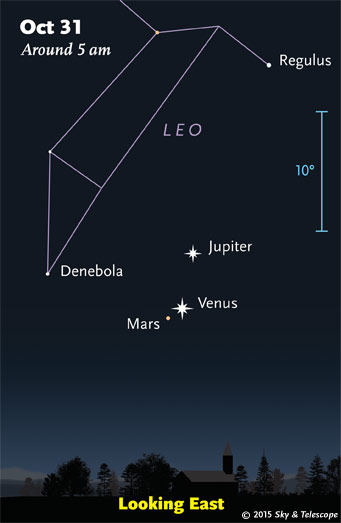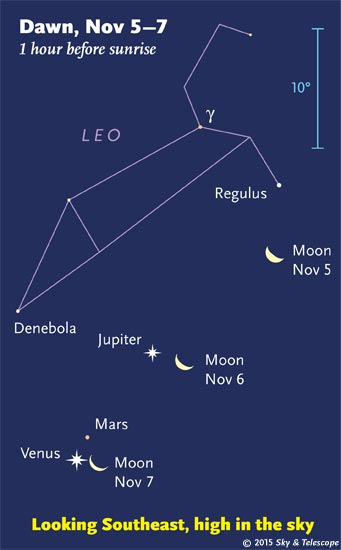Taurid fireball alert. The long-lasting Taurid meteor shower is sparse, but a high proportion of its meteors are bright. This year we're predicted to see more of them than usual, perhaps even a repeat of the 2005 "Halloween fireballs" that made news around the world. The fireball likelihood actually continues well after Halloween, through about November 10th. See the article in the November Sky & Telescope, page 44.

Friday, October 30
• Sometime around 7 or 8 p.m., depending on where you live in your time zone, bright Capella is exactly as high in the northeast as Fomalhaut is in the south.
• On Saturday (North American date), the quarter-mile asteroid 2015 TB145 passes 1.3 lunar distances from Earth. It will reach 10th or 11th magnitude (100 times too faint to see with the unaided eye) as it crosses the northern sky of the early-morning hours. See our article and chart: Close-in Asteroid Offers Halloween Treat.
A webcast of the flyby: Gianluca Masi has marshaled a network of observers to provide real-time views via his Virtual Telescope Project. Watch the webcast starting at 0:00 UT October 31st, which is 8:00 p.m. Friday October 30th EDT.
Saturday, October 31
• The waning gibbous Moon this Halloween doesn't rise until around 9 p.m. (depending on where you are). Once the Moon is well up, look for Orion far to its right, and Gemini's Castor and Pollux off to its left.
• Daylight-saving time ends at 2 a.m. Sunday morning. Clocks fall back an hour (for most of North America).
• In Sunday's dawn, Venus has drawn to within 1.1° of little Mars, even closer than shown above. Mars is only 1/250 as bright. They'll appear closest together on the mornings of Monday and Tuesday, November 2nd and 3rd.
Sunday, November 1
• Before and during dawn Monday, brilliant Venus and faint orange Mars are separated by just 0.8° — less than a fingertip at arm's length. Jupiter looks on from above. In a telescope, Venus is a dazzling white half-moon 22 arcseconds from top to bottom. Mars, currently on the far side of its orbit from us, is a tiny orange blob just 4 arcseconds in diameter.
Monday, November 2
• The last-quarter Moon rises around 11 p.m. tonight, in dim Cancer far below Pollux and Castor. Spot Procyon well to the Moon's upper right. (The Moon is exactly last-quarter at 7:24 a.m. Tuesday the 3rd EST.)
• Before and during dawn Tuesday, Venus and Mars are in conjunction 0.7° apart, with Jupiter above them.
Tuesday, November 3
• Around 9 p.m., depending on where you are, zero-magnitude Capella rises exactly as high in the northeast as zero-magnitude Vega has sunk in the west-northwest. How accurately can you time this event? Astrolabe not required. . . but it would help.
Wednesday, November 4
• Algol should be at its minimum brightness, magnitude 3.4 instead of its usual 2.1, for a couple hours centered on 8:30 p.m. EST according to its recently revised predictions. Comparison-star chart.

Thursday, November 5
• By about 9 p.m. Orion is clearing your eastern horizon (depending on how far east or west you live in your time zone). High above Orion shines orange Aldebaran. Above Aldebaran is the little Pleiades cluster, the size of your fingertip at arm's length. Far left of the Pleiades shines bright Capella.
• The waning Moon shines with Jupiter before and during dawn on Friday morning the 6th, as shown at right. Venus and Mars are below them. Think photo opportunity: Use a tripod, a long lens or zoom, and include a bit of foreground. Send your shot to our online gallery!
Friday, November 6
• In the dawn of Saturday the 7th, the waning crescent Moon has stepped down a notch to shine strikingly paired with Venus, as shown at right. Faint Mars close by makes it a triangle. Jupiter shines above them.
Saturday, November 7
• Algol should be at its minimum brightness, magnitude 3.4 instead of its usual 2.1, for a couple hours centered on 5:20 p.m. EST according to recently revised predictions. Watch it rebrighten for several more hours through the course of the evening. Comparison-star chart.
__________________________
Want to become a better astronomer? Learn your way around the constellations. They're the key to locating everything fainter and deeper to hunt with binoculars or a telescope.
This is an outdoor nature hobby. For an easy-to-use constellation guide covering the whole evening sky, use the big monthly map in the center of each issue of Sky & Telescope, the essential guide to astronomy.

Once you get a telescope, to put it to good use you'll need a detailed, large-scale sky atlas (set of charts). The standards are the little Pocket Sky Atlas, which shows stars to magnitude 7.6; the larger and deeper Sky Atlas 2000.0 (stars to magnitude 8.5); and once you know your way around, the even larger Uranometria 2000.0 (stars to magnitude 9.75). And read how to use sky charts with a telescope.
You'll also want a good deep-sky guidebook, such as Sue French's Deep-Sky Wonders collection (which includes its own charts), Sky Atlas 2000.0 Companion by Strong and Sinnott, the bigger Night Sky Observer's Guide by Kepple and Sanner, or the beloved if dated Burnham's Celestial Handbook.
Can a computerized telescope replace charts? Not for beginners, I don't think, and not on mounts and tripods that are less than top-quality mechanically (meaning heavy and expensive). As Terence Dickinson and Alan Dyer say in their Backyard Astronomer's Guide, "A full appreciation of the universe cannot come without developing the skills to find things in the sky and understanding how the sky works. This knowledge comes only by spending time under the stars with star maps in hand."
This Week's Planet Roundup
Mercury is bright (magnitude –1.0), but it's settling down closer to the east-southeast horizon in bright dawn every day. Look for it there about 30 minutes before sunrise, far beneath and perhaps a bit left of Venus, Jupiter, and Mars. Late in the week, don't confuse it with fainter, twinkly Spica emerging into view nearby. Binoculars help.
Venus, Mars, and Jupiter continue showing off together in the eastern sky before and during dawn. Venus is the brightest at magnitude –4.5. Jupiter is –1.8, and Mars is much fainter at +1.7.
Watch their pattern changing from morning to morning. Venus is descending; Jupiter and Mars are rising. Venus passes close by faint Mars (only 1/250 as bright!) on November 2nd and 3rd, when they'll be 0.8° and 0.7° apart, respectively.
Saturn (magnitude +0.6) disappears very low in the southwest during twilight. Bring binoculars. Don't confuse Saturn with orange Antares twinkling 9° to its left or lower left. Good luck.
Uranus (magnitude +5.7, in Pisces) and Neptune (magnitude +7.8, in Aquarius) are high in the southeast and south, respectively, by 8 p.m. standard time. Finder charts for Uranus and Neptune.
__________________________
All descriptions that relate to your horizon — including the words up, down, right, and left — are written for the world's mid-northern latitudes. Descriptions that also depend on longitude (mainly Moon positions) are for North America.
Eastern Daylight Time (EDT) is Universal Time (UT, UTC, or GMT) minus 4 hours. Eastern Standard Time (EST) is UT minus 5 hours.
__________________________
“This adventure is made possible by generations of searchers strictly adhering to a simple set of rules. Test ideas by experiments and observations. Build on those ideas that pass the test. Reject the ones that fail. Follow the evidence wherever it leads, and question everything. Accept these terms, and the cosmos is yours.”
— Neil deGrasse Tyson
 0
0
Comments
You must be logged in to post a comment.